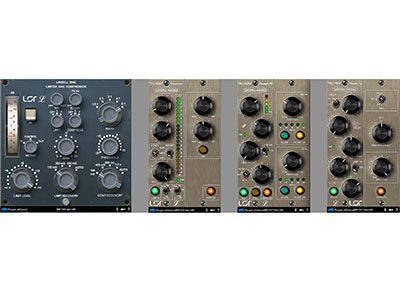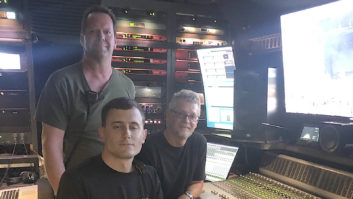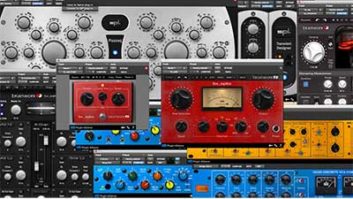
Lindell Audio is a Swedish company offering a range of hardware and software products for audio production. The 100% Lindell Bundle includes all four plug-ins made by the company: the 254E, PEX-500, 7X-500 and 6X-500. The collection comprises digital emulations—with significant modifications—of classic Neve, Pultec and UREI hardware units and the modern Lindell 6X-500 (a transformer-coupled preamp and 2-band, passive equalizer). I reviewed Version 1 of the bundle in Digital Performer V. 8.06 and 9.01 (DP), using an 8-core Mac Pro running OS X 10.9.5.
254E Compressor/Limiter
The 254E emulates—with slight modifications—the vintage Neve 2254E compressor/limiter, which uses a diode bridge as its gain-control element. The limiter and compressor sections each have separate threshold, mode and release-time controls; the latter each includes an auto-release setting. The mode control for each processor is a three-way switch that selects slow or fast attack time or bypasses the processor. (The compressor’s fast attack time is equal to that for the Neve 2254E, which offered only one attack time.) The Ratio control serves the compressor and selects values from 1.5:1 to 6:1. Other controls adjust makeup gain for the compression stage; select dry, wet or mixed signal at the output (the Mix setting produces parallel compression); activate and adjust a highpass filter in the sidechain; bypass the entire plug-in; and switch the VU meter to show input, output or gain-reduction levels.
The GUI displays threshold and I/O levels in calibrated analog terms instead of using the actual digital values you’re working with in your DAW (for example, +4 dBu in the GUI equals -18 dBFS). It’s otherwise very intuitive.
PEX-500 EQ
The Pultec-inspired PEX-500 offers three bands of EQ, two for highs and one for bass frequencies. You can select 10, 15 or 20 kHz for the high-shelving filter’s corner frequency; this filter can only attenuate gain, using a separate control. A high-frequency bell-curve filter—fitted with separate boost and bandwidth controls—boosts gain at 3, 4, 5, 6, 8, 10 or 16 kHz depending on a switch setting; this filter can’t attenuate gain. A low-shelving filter offers separate boost and attenuation controls that act at the same corner frequency: 30, 60 or 100 Hz. Because the equalization slopes are different when boosting versus attenuating, simultaneous and proportionate use of both controls at the same corner frequency will not cause complete cancellation; rather, you end up with complementary and asymmetrical boost and cut in adjacent bands. This, along with passive circuitry, is the root of the clear and punchy Pultec sound that the PEX-500 emulates.
In stereo configurations of the plug-in, you can flip a switch to apply equalization to either the mid or side channel (instead of processing left and right channels). A global bypass is provided for the EQ. The Input Pad control attenuates the equalizer’s input signal.
7X-500 Limiter
The 7X-500 models the Lindell Audio FET compressor by the same name. A UREI 1176-inspired processor, the GUI provides both continuously variable and stepped attack and release time controls; a button activates the continuously variable controls. The stepped controls are three-way switches with slow, medium and fast settings. Other buttons toggle the compressor and stereo linking on and off, and a rotary control varies the amount of inter-channel linking from 0 (fully unlinked) to 100%. Other virtual knobs adjust input gain (and simultaneously threshold), makeup gain and dry/wet mix (for implementing parallel compression). Two three-way switches respectively select the ratio (4:1, 12:1 or 100:1) and the corner frequency for the sidechain’s HPF (100 or 300 Hz, or unfiltered). A 20-segment, LED-style gain-reduction meter completes the package.
6X-500 Preamp and EQ
This plug-in emulates the analog Lindell 6X-500. High- and low-frequency boost controls act on switch-selectable frequencies: 6, 10 or 16 kHz for high bell-curve boost, and 30, 60 or 100 Hz for low-shelving boost. (These filters can only boost, not cut.) You can separately adjust the provided high- and lowpass filters between 20 and 20,000 Hz and select any of five available slopes—ranging from 6 to 36 dB/octave—for each filter; the HPF and LPF can also be independently bypassed. Two switches respectively invert the plug-in’s phase and bypass its boost circuits.
The PEX-500, 6X-500 and 7X-500 each provide an Analog button; when it’s switched on, it emulates the noise, output-transformer saturation and power-supply hum produced by the plug-in’s hardware counterpart.
Rock On
The 7X-500 sounded phenomenal on a crunchy electric guitar vamp. The guitarist played palm-muted, descending eighth notes on the lower strings alternately with blazing triads on the higher strings. By selecting a medium attack, fast release, 100:1 ratio and 300Hz corner frequency for the sidechain’s HPF, I could make the 7X-500 clamp down hardest on the triads and make the crunchy, staccato bass line pop out and drive the groove. Awesome! The 7X-500 also sounded very good on bass guitar with a parallel-compression setup; a slow attack and fast release made the track pulse, and activating the Analog function warmed the sound nicely.
The 254E sounded outstanding on room mics for drums—in fact, better than the 1176-inspired 7X-500 (which was ho-hum in this application). Using a fast attack and recovery for the compressor—and a 6:1 ratio—produced an explosive sound. I could tailor how much the kick got compressed versus the snare by adjusting the sidechain frequency between roughly 80 and 200 Hz. Using similar settings, but using parallel compression and kicking in the limiter, lent an urgent sound to rock male vocals; I could strongly emphasize the singer’s breathing, lending a desperate vibe to the track. Cool!
I got very good results using the PEX-500 on kick drum and electric bass guitar tracks; the interacting boost and cut controls for the low-shelving band cranked up the low end while simultaneously clearing out muddy frequencies, creating a punchy and focused sound. Used on DP’s master bus, boosting and cutting the mid channel at 30 Hz helped bolster a mix’s weak bottom impressively without blurring the upper-bass range. The PEX-500 wouldn’t be my first choice for equalizing vocals, however (and in all fairness, neither would a Pultec equalizer); its selection of low- and mid-bass shelving curves didn’t offer enough flexibility and control for sculpting a singer’s low end. But I loved how the Analog function warmed up and thickened an edgy, thin-sounding female singer.
I got a big electric-bass sound using the 6X-500 by cranking the input gain to distortion, using the LPF to roll off resulting top-end fizziness and boosting generously at 60 Hz. But as it only offers filters for bass and high frequencies (and can only boost their gain), I didn’t find the 6X-500 particularly useful for equalizing vocals and midrange-y instruments such as electric guitars. Used on a full mix (a largely acoustic ballad) to lightly sweeten extreme highs and lows, the Analog function caused audible, unpleasant distortion. With that function disabled, the 6X-500 sounded okay but didn’t produce as round of a bottom or as sweet of a top end as my SPL Passeq equalizer plug-in (the gold standard for passive-EQ emulation). And the Passeq preserved the mix’s depth much better.
I wished the two dynamics processors had external-sidechain inputs. The PEX-500 would benefit from having output-level meters, and separate gain-reduction meters for the 254E’s compressor and limiter would aid setup. My only other complaint concerns the graphics for vertically actuated toggle switches: simulated light reflection off the toggles made it slightly difficult to discern the switches’ current settings.
But the 100% Lindell Bundle offers a lot for your money. The only underachiever in the lot is the 6X-500. Rock engineers will especially appreciate the two dynamics plug-ins, the 254E and 7X-500. Considering the product’s relatively low price, that’s enough for me to give the 100% Lindell Bundle a firm buy recommendation.
Michael Cooper is a recording, mix, mastering and post-production engineer and a contributing editor for Mix magazine.
Try This
To get a truly explosive sound on room mics for drums, chain the 254E and 7X-500 in series. Select the highest available ratio for each plug-in, fast attack and recovery times for the 254E, and medium attack and release times for the 7X-500. Be sure to wear a Kevlar jacket!
PRODUCT SUMMARY
COMPANY: Lindell Audio
PRODUCT: 100% Lindell Bundle
WEBSITE:Plugin-alliance.com (distributor)
PRICE: $349
PROS: Three of the four plug-ins sound very good to outstanding. Compressors have internal sidechain filters, allow parallel compression. PEX-500 includes M/S mode. Reasonable price.
CONS: 6X-500 is mediocre. No external sidechain inputs for compressors. Limited filter selections for equalizers. 254E displays confusing levels.






